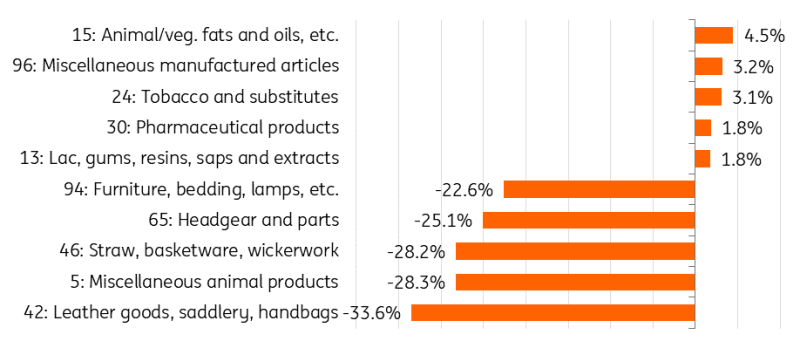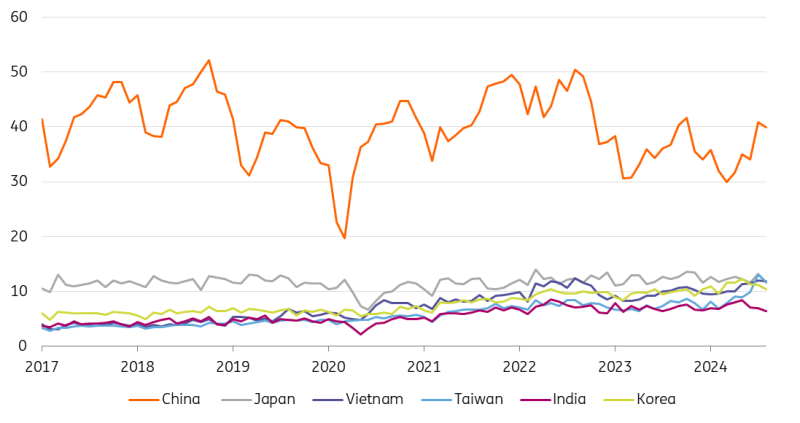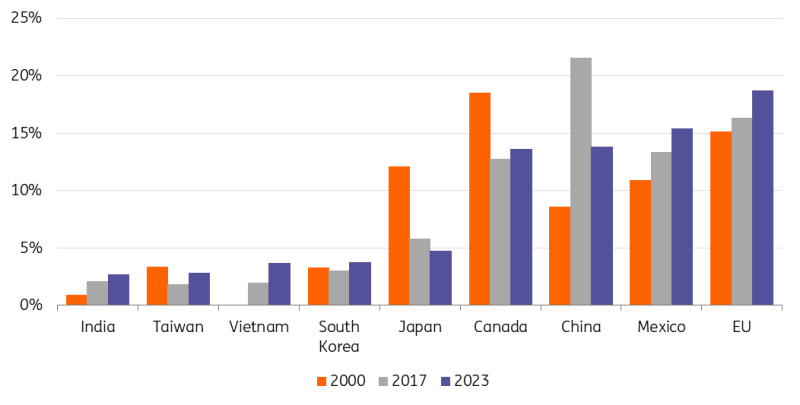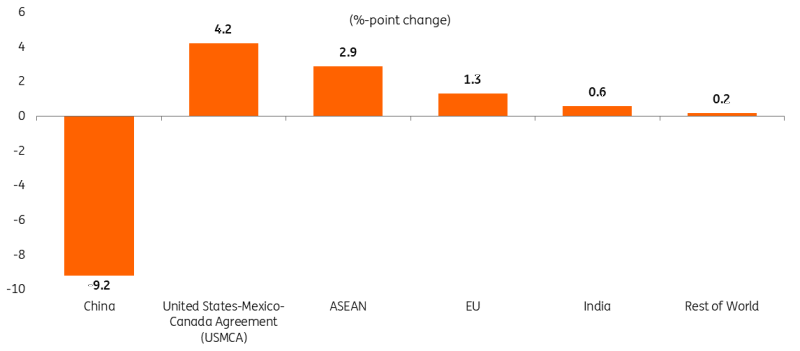Since Donald Trump took office in 2017, trade flows and market shares have changed substantially. We think that shift is set to continue under looming tariffs and a new protectionist environment.
China’s declining US market share
The global market landscape has undergone significant transformations since the onset of the US-China trade dispute in 2018. The imposition of tariffs and a shift towards protectionism have forced companies on both sides of the Pacific to rethink their supply chains and sourcing strategies. Chinese firms, in particular, have seen a notable decline in their US market share.
By 2023, China’s overall market share in the US had dropped by 7.7 percentage points to 13.9%, with even steeper declines in tariff-affected sectors. For instance, the market share for Chinese leather goods and furniture plummeted from 57.2% to 23.7%, and from 52% to 29.4% to between 2017 and 2023.
Sectors in which the Chinese market share in the US has shifted the most between 2017 and 2023
(%-points, HS2).
Source: LSEG Datastream; Global Trade Tracker, ING
Despite tariffs, China remains a key import source for the US
Despite the overall decline, not all sectors have suffered. China has managed to increase its market share in specific areas, such as animal and vegetable fats, tobacco and pharmaceutical products and miscellaneous manufactured articles, albeit from a relatively low base for the former three categories.
More importantly, though, China remains the most crucial source of imports from key Asian countries for the US. While hefty tariffs have somewhat reduced the country's direct dependency on Chinese imports, they have not led to a complete departure.
US imports from selected Asian countries ($bn)
Source: LSEG Datastream, ING
When two people quarrel, the third benefits
Still, the tariffs on Chinese goods have prompted companies to seek alternatives, with some shifting production to other countries to avoid the tariffs. As trade in goods between the US and China has declined, both nations have sought out other markets, leading to significant gains for some countries. Between 2017 and 2023, the share of imports into the US from the EU, Mexico, and Vietnam increased by 2.4ppt, 2.1ppt, and 1.7ppt respectively. Additionally, Taiwan, Canada and South Korea have also boosted their export market share to the US by 1ppt.
Share in total US imports (%)
Source: LSEG Datastream, ING
Some changes are due to recent trade conflicts, but not all shifts can be directly attributed to the escalation. Supply chain adjustments are influenced by competitive dynamics, environmental considerations, consumer preferences, and regulatory aspects. While a tougher trade environment has driven many changes, it’s crucial to recognise that the multi-faceted nature of supply chains also plays a role here.
It is therefore useful to look at the share of imports subject to additional tariffs, such as those under Section 301. The USTR report reveals that several countries have benefited; Mexico and Canada saw their market shares increase by 4.2 and 2.9ppt respectively. The EU and India also made gains, with increases of 1.3 and 0.6ppt each.
Market share changes of US imports for Section 301 Products (Lists 1-4A)
2023 vs. 2017.
Source: Office of the U.S. Trade Representative; U.S. Census
China, on the other hand, has increased its exports primarily to Russia, Vietnam, Africa, the EU and Mexico. Overall, it seems that Mexico and Vietnam may serve as “plus one” countries, acting as intermediaries for China’s trade with the US and vice versa.
How tariff policies could Impact Vietnam, Mexico, and many more
This time around, however, those beneficiaries might get caught in the crossfire. Mexico is already in the spotlight not because of its trade policies, but due to immigration – and looking ahead, it might face increased scrutiny and renewed tariff threats stemming from actual trade imbalances. Additionally, the bigger threat from a new trade war could come from the US administration targeting foreign companies operating in third countries like Mexico or Vietnam, and potentially even targeting goods passing through Chinese-operated ports worldwide. There is still immense uncertainty about trade policies for the next four years, but being prepared for multiple potential scenarios might be the best approach.
We will also be closely monitoring the US currency manipulator list, as this might provide a hint about who will be targeted next. While no trading partners met all the criteria required to be labelled a currency manipulator in the June 2024 report, seven economies were put on the US Treasury list for monitoring: China, Japan, Taiwan, Malaysia, Singapore, Vietnam, and Germany.
Trade will be a primary focus under Trump’s renewed presidency – and in turn, the supply chain landscape, trade flows and market shares will continue to evolve as we enter a new era of protectionism with looming tariffs.
Read the original analysis: How the US-China trade dispute is redefining global trade
Content disclaimer: This publication has been prepared by ING solely for information purposes irrespective of a particular user's means, financial situation or investment objectives. The information does not constitute investment recommendation, and nor is it investment, legal or tax advice or an offer or solicitation to purchase or sell any financial instrument. Read more here: https://think.ing.com/content-disclaimer/
Recommended Content
Editors’ Picks

EUR/USD attacks 1.0800 ahead of EU inflation data
EUR/USD is battling 1.0800 in the early European session on Tuesday, undermined by the latest US Dollar bounce. Traders keenly await the EU inflation data and the US jobs survey for further impetus as US President Trump's 'reciprocal tariffs' announcement looms on Wednesday.

GBP/USD treads water above 1.2900 ahead of US data, tariffs
GBP/USD is trading on the defensive while holding above 1.2900 in Tuesday's European trading. The pair loses ground amid a modest US Dollar uptick as traders resort to repositioning in the lead-up to the top-tier US economic data releases and Wednesday's tariffs announcements.

Gold price eases from record high; bullish bias remains amid worries over Trump's tariffs
Gold price retreats slightly after touching a fresh all-time high on Tuesday as bulls pause for a breather and opt to wait for US President Donald Trump's reciprocal tariffs announcement. Adding to this, a positive tone around the Asian equity markets also acts as a headwind for the commodity amid overbought conditions on the daily chart.

PEPE could rally to double digits if it breaks above its key resistance level
Pepe memecoin approaches its descending trendline, trading around $0.000007 on Tuesday; a breakout indicates a bullish move ahead. Moreover, PEPE's long-to-short ratio supports a bullish thesis as bullish bets among the traders reach the highest over a month.

Is the US economy headed for a recession?
Leading economists say a recession is more likely than originally expected. With new tariffs set to be launched on April 2, investors and economists are growing more concerned about an economic slowdown or recession.

The Best brokers to trade EUR/USD
SPONSORED Discover the top brokers for trading EUR/USD in 2025. Our list features brokers with competitive spreads, fast execution, and powerful platforms. Whether you're a beginner or an expert, find the right partner to navigate the dynamic Forex market.



